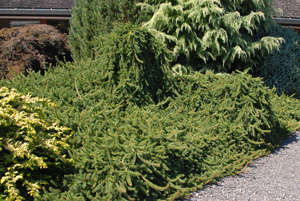Resource Library
Plant of the Week: Weeping Norway Spruce
The University of Arkansas System Division of Agriculture does not promote, support or recommend plants featured in "Plant of the Week." Please consult your local Extension office for plants suitable for your region.
Plant of the Week
Weeping Norway Spruce
Latin: Picea abies ‘Pendula’

When on a road trip with my wife, I often drive her to distraction by identifying the passing trees as we whiz by at 70 miles an hour. Within a given species, most trees have a certain profile that makes them easily recognizable, but invariably there are always individuals that fall outside of the norm. Weeping trees, such as the weeping Norway spruce (Picea abies ‘Pendula’), are outliers that make interesting specimen plants in the landscape.
What are the characteristics of the weeping Norway Spruce?
Norway spruce is the most common spruce in the American landscape because it is the most adaptable, and it grows in most portions of the country except the Deep South and the desert west. Its usual form is that of a conical tree to 60 feet tall with a pyramidal habit 4 to 5 times taller than it is wide.
Its evergreen needles are three-fourths of an inch long, overlapping and sharp-pointed with a deep green color that, in winter, takes on a brooding, blackish green look. On old trees, spruces produce pendulous, brownish, banana-shaped cones that are 5 to 6 inches long.
What are the origins?
Norway spruce was introduced into the United States during the Colonial Era from the Old World, where it is found over wide swaths of northern Europe. As a landscape subject, the large tree form was the Bradford pear of the late 19th century and was planted everywhere in excess. Eventually it fell from favor and became associated primarily with old cemeteries, where its association with death didn’t help people develop a close relationship with the species.
The weeping form, like many other novelty forms of dwarf and slow-growing conifers, made an appearance in the nursery market in a big way during the late 19th century, when rock gardening became the rage. Weeping and dwarf conifers often came from mountainous regions, and they fit in more comfortably with the smaller scale of the rock garden.
What causes a plant to have a weeping habit of growth?
The weeping habit of growth, including the weeping form of Norway spruce, is because of a biochemical misstep in the sequence of wood hardening in the stem. In typical plants, new growth emerges from a dormant bud in the spring and extends rapidly to its full length. Then, beginning at the base of the new stem, the stem begins to get harder, or woodier, from the base of the branch towards its tip. If the timing is right, the stem hardens before the forces of gravity bend it downward. If it bends downward before stem hardening occurs, you end up with a weeping plant. It’s all in the timing.
We all have experienced firsthand this process of stem hardening. Asparagus shoots, if collected at the right moment and quickly refrigerated, are crispy and delicious through their entire length. But, sometimes only the tip of the spear is crispy, with the basal portion of the shoot woody.
Cell wall development occurs in two distinct steps. In the first stage of cell development, a cellulose envelope forms that defines the basic size and shape of the cell. In this initial stage the cell is extremely pliable, but in woody plants, a secondary cell wall begins forming that adds strength and rigidity to the cell. In woody plants, the cellulose matrix is in-filled with pectins, hemicelluloses and especially lignin. The transition from flexible to woody begins with the oldest cells at the base of the stem and progress upwards to the tip. As all okra connoisseurs know, this transformation occurs quickly, with a five-day-old pod just right while a six-day-old pod is too woody to eat.
What do I need to know about using weeping plants in my landscape?
Weeping plants make wonderfully picturesque plants in the landscape, but care and discretion must be used in locating them. In the wrong place they look odd and unusual, but if well-sited, they become an interesting focal point in the garden. Weeping Norway spruce tends to be a sprawler, so staking may be needed to get it to grow tall enough to present itself well in the landscape. No two weeping Norway spruces are exactly alike, but generally they are around 15 feet tall and up to twice that width. Once it attains some size, judicious pruning to direct its development will help create the perfect picturesque specimen and help control size.
By: Gerald Klingaman, retired
Extension Horticulturist - Ornamentals
Extension News - January 14, 2011
The University of Arkansas System Division of Agriculture does not maintain lists of retail outlets where these plants can be purchased. Please check your local nursery or other retail outlets to ask about the availability of these plants for your growing area.